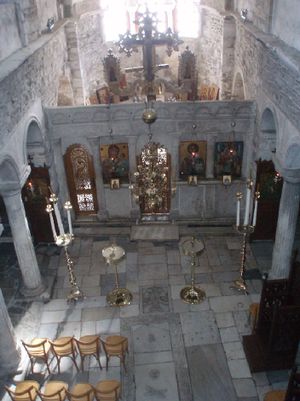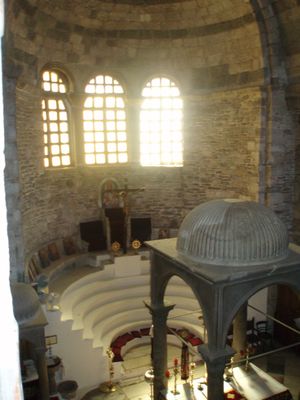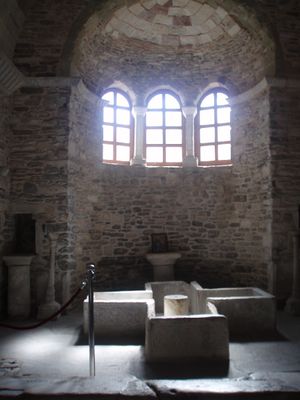Church of Panagia Ekatontapyliani - Hundred Doors (Paros)
The Church of Panagia Ekatontapyliani is one of the most significant Byzantine monuments of Greece and is situated in Pirikia, the capital of Paros island, a short distance from its port; east of the old town of Paros. It is one of the oldest Christian temples which is to be found in Greece. It's real name is Katapoliani which means kata and polis - "towards the city"; or towards the ancient city. Its official, and more common name, Ekatontapyliani is a creation of 17th century scholars who wanting to give it more worth named it like the ancient hundred gates of Thibes in Egypt. The church commemorates is main feast day August 15.
Contents
History
Many stories circulate regarding the construction of the temple. The more common identifies St. Helen as the founder. On her way to the Holy Land to find the Holy Cross, her boat docked in Paros. Near the port, there was a small temple, and inside this temple she prayed and made a vow that if she should find the Holy Cross, she would build a big temple on that site. She did find the Holy Cross and fulfilled her vow by building the temple. The other story mentions that St. Helen could not fulfill her promise and instructed her son, Emperor Constantine the Great to do so and he fulfilled her wish. A third version, narrates that no temple existed on this site prior to the 6th century. However, Emperor Justin wanted to strengthen the religious sentiment of the island and built the temple.
In c. 1962, the church was renovated by the renowned professor and academic Anastasios Orlandos. His research proved that the rightful constructers were indeed Constantine and Helen. He also proved the existence of a temple dating from the 4th century.
Professor Orlandos commenced refurbishments of the church which required seven years to complete. This was achieved by 1966.
The Main Temple
The Iconostassis
Chapels
- The Chapel of St. Theoktiste of Lesbos.
- See Main Article on St. Theoktiste of Lesbos (November 9) [1] [2]
- In the northern wall of the temple is the small chapel of St. Theoctiste. There is an enclosed tomb in which once contained the relics of the saint.
- The Chapel of St. Nicholas
- This chapel measures 19x15m and is situated north of the altar of the main temple. It is the oldest chapel, not only of the entire church but of the whole island. Many archaeologists believe that this is the spot that St. Helen prayed before venturing to find the Holy Cross in Jerusalem.
- The Chapel of the Holy Unmercenaries Ss. Anargyron
- The Chapel of St. Philip
- This chapel (8x2.5m) is to the south of the Chapel of the Holy Unmercenaries and is connected directly with it; though it has a separate ceiling.
- The Chapel of St. Theodosia
- The Chapel of St. Demetrios
The Baptismal Font
Portable Icons
- The "Praying Virgin" (circa 15th Century)
- The "Pure One" (circa 16th century)
- The "Holy Trinity - St. Zion"
- The "Panagia Eleousa"
The Old Monument Gate and its Legend
Images from a Pilgrim
See also
Notes
- ↑ What we know about St. Theoktisti we owe primarily to St. Symeon Metaphrastes ("the Translator"), renowned primarily for his Lives of the Saints (148 of them).
- ↑ Theoctiste is from Lesbos, however, due to the archaeological and historical importance of her association with the Church of Panagia Ekatontapyliani - Hundred Doors she is also classified as a Parian local saint; she lived inside the church before dying martyrically at the hands of pirates.


